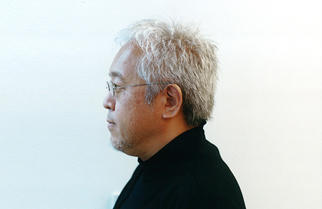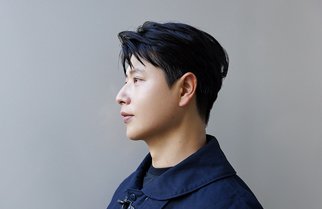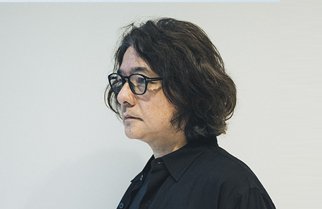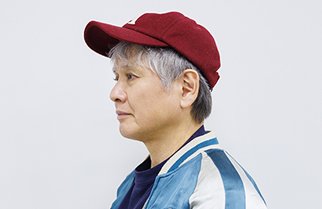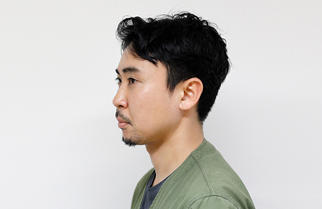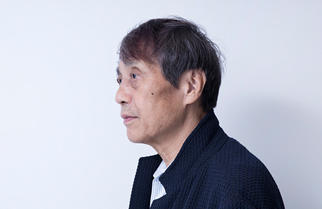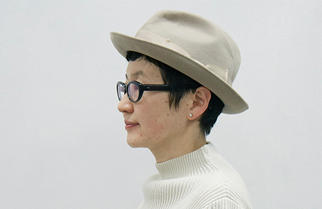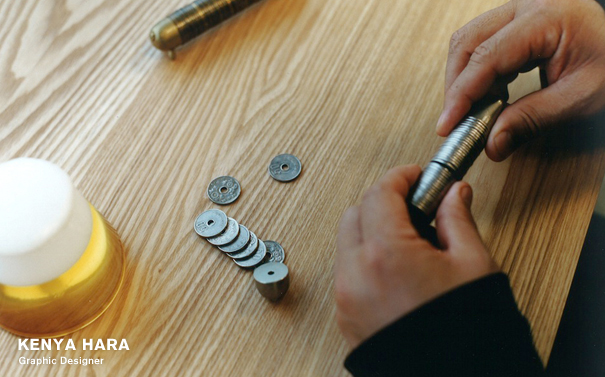
29 Kenya Hara (Graphic Designer)
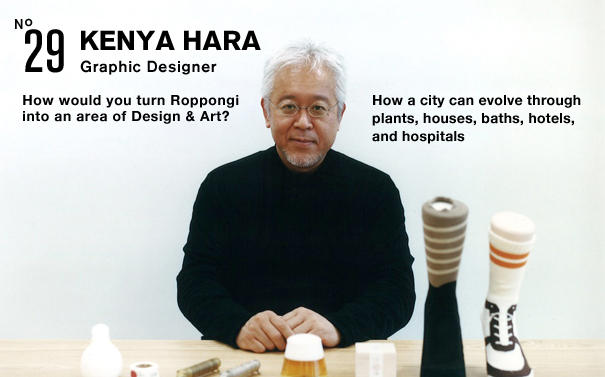
One of Japan's foremost graphic designers, Kenya Hara serves as a judge at the "Tokyo Midtown Award" competition which is in its sixth year this year. For this interview, Hara started talking almost immediately after he sat down. "Cities are important," he began. "I think Roppongi could become an area of design and art if we combine the things that are of interest to me at the moment." Continuing at a fast pace, Hara told us about his five ideas - plants, houses, baths, hotels and hospitals-and how they could change the future of Roppongi.
Plants and Roppongi - a huge glasshouse with lush greenery
It would be impressive if there were lots of large luffa plants growing inside Tokyo Midtown. I think we should consider creating spaces in cities where plants can grow thickly - not just spaces where some flowers are growing or are decorated with greenery. As artificial technology becomes more advanced, I think that the boundaries of nature will fade. In addition to vertical greenery systems and roof gardens, I feel that there is potential in glasshouses and indoor plants.
The Netherlands is a leading country in glasshouse technology. In Japan, most of the land has always been covered with forests and there is a strong tradition of nature worship, but in the Netherlands, more than a third of the land is developed land, and the plants and forests have been made by its people. In other words, much of the natural environment has been artificially created. In addition to the glasshouses that are used for farming, the Netherlands has modern architecture and facilities, and I have been wondering for a long time how cities in Japan could incorporate some of those aspects. So if I were to build a high-rise building, I would build a huge glasshouse at the bottom. Since the building would have air-conditioning anyway, I would have the environment made to be suitable for lush greenery. And inside this huge glasshouse, I would build offices and restaurants. It need not be like a conservatory where the temperature and humidity must be kept high; surely there is an environment that is just right for humans and for certain plants. It would be pleasant to work and have meals in such a place.
Houses and Roppongi - Making your own house in the city
In March this year, we held an exhibition called "HOUSE VISION" which proposed ways for people to live in the city in the future. Industries related to energy issues, to transport and communications and to integrated electronic appliances - these industries which hold promise for the future are all related to housing. The relationship between houses and residents is about to change drastically. I think there is going to be more renovation of houses, and people are going to pay more attention to their homes.
So far, the Japanese have not had much "literacy" when it came to building of homes. But being able to create by yourself a space that is suited to your own lifestyle is the basis for happy everyday living. The question should be not what kind of house you live in, or what kind of house you bought, but what kind of house you built. One can't be satisfied with simply being rich. Living in the city means using the functions of the city, so a bookstore can become your library, and a restaurant can become your dining room, and a coffee shop can become your living room. That means that maybe your home can be small. You might even have a small bedroom in one place and a living room in another place. Thinking about making homes in Roppongi means that you start considering how to change the small and old spaces in Roppongi; seriously thinking about these things is a lot of fun in itself.
Baths and Roppongi - appreciating modern architecture while naked
I love onsen (hot springs) and baths, but I have this slight hesitance toward the bathhouses that exist now such as those called "onsen land" and "super sento." I can't help wondering why they don't think more deeply about design and art for these places.
I'm a big fan of the Swiss architect Peter Zumthor, and I love the spa facility "Therme Vals" built in the Alps mountainside. It's such a wonderful place that I visited it twice, in the summer and in the winter. The building is set right in the middle of the natural landscape, with half of it being semi-basement and half of it consisting of outdoor pools. Small spaces and large spaces are connected in a maze-like way, and the design is based on an understanding that spas are places for meditation and for generating life.
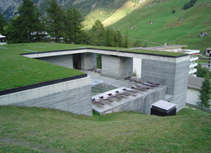
Therme Vals
A spa facility in Switzerland reputed to be the best in the world. Designed by architect Peter Zumthor, it is located in Vals, a small village in the valley with a population of 1,000. Making use of locally-quarried stone, the building blends in with the natural Swiss landscape. Since its completion in 1996, it has drawn and charmed many people from all over the world.
If there was a similar place in Japan, where people could enjoy the latest modern architecture while naked and relaxing in water and hot water, I'm certain everyone would go to it. Such a spa should be built in Roppongi. If there was a spa facility which was the epitome of urban sleekness, people will undoubtedly go there on their days off. It would be great if the facility also had a good bookstore and coffee shop. I suppose it would appropriate to call such a facility a "spa house" and not an "onsen". If there is anyone interested in building such a facility, please be sure to contact me!

Hotels and Roppongi - a lifestyle combining work and leisure
Many of the people who are working busily in Asia now are people who are constantly on the move. They might go to Jakarta one day, and then to Beijing and later to Taipei, and then spend two nights in Tokyo before returning to Jakarta - that's the way they work. Unlike Westerners, they don't take a vacation for a month and stay in the same place. But it's not that that they are not resting at all; I think their holidays and work are mingled. That's also the case with me: there is pleasure combined in my work - my work includes rest.
Business hotels were made for people who are working, while resort hotels were made for people who are on holiday, but I think there should be hotels for people like myself whose work and holidays are mixed. Imagine a comfortable environment where you can go online and the Web is functioning smoothly and you are half-resting and opening your laptop from time to time. You are free to look at all the movies you like and listen to all the music you like. Next to the spa house that I just mentioned, a small hotel could be built. The bedroom itself might be small, but there could be good public spaces in the vicinity. Roppongi is already a place for work, so we should consider how to bring in the element of leisure. That would no doubt lead to ideas for a new kind of hotel.
Hospitals and Roppongi - city facilities offering medical services
There is the Japanese word "mibyo" which refers to the state of a body before it becomes ill, and I think this is something that the Japanese will be increasingly paying attention to. It would be good if Roppongi had medical facilities where people could take health checks when they are still in the "mibyo" stage; the ideal facilities would be those that have such nice environments that people would want to go there for checkups.
I think that from now on, it will become essential for the average Japanese to take good care of themselves during the "mibyo" stage. By 2050, Japan will become an ultra-aging society with more than 40% of the population over the age of 65. At the same time it will become a society where one must not become a "rojin" (old person). A 65-year-old man is acceptable but a 65-year-old "rojin" is not. Because such a person has nearly 20 years left to live. And these people have the highest bank savings in the world.
The ideal is not to become a person who needs care, but to stay healthy enough to remain a part of the working population. So we need to have thorough health checks, but there are no places yet where health checks are conducted in a pleasant environment. If such places were created, I think it will be a stimulus for the economy. It may not sound proper to talk about hospitals when talking about design and art, but in pursuing happiness in our lives, I think we must ultimately question what we should do about our hospitals.
Urbanization and the culture of grownups
I've talked about plants, houses, baths, hotels and hospitals as they have come up in my mind but I believe that each of these genres deserve a great deal of thought in the context of how they can contribute to the evolution of city life. There are so many problems in Japan that need to be solved. If we become aware of each one of these problems and address them, there is hope.
In my mind, cities are important because I think people's lives will become increasingly city-oriented in the future. It's in people's instincts to live close to each other; I don't think the trend is for people to live farther apart. The local suburbs are important too, but they are not places where values of the future can be integrated. Particularly since we are going to become an aging society, we need to have adult society and culture flourishing in the cities. A prosperous mature society will no doubt be appreciated by the young people too.
Up till now, city culture has exclusively been about youth culture. From the 1970s-when the TV program "YOUNG OH! OH!" startedand people walked the streets wearing jeans and eating cup noodles- to the recent club culture, the young have always been at the center. But from now on, I think we are going to enter a different phase; we are going to have a full-fledged grownup culture in Tokyo.
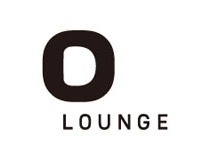
Musashino Art University Design Lounge
A lounge within the Tokyo Midtown Design Hub on the 5th floor of Midtown Tower. The space is open to everyone, and visitors can casually come and gain the latest information about the art university. The logo design is by Kenya Hara, professor of Musashino Art University's Department of Science of Design.

Tokyo Midtown Award
A competition open to the general public made up of the art competition and design competition. At the design competition, at which Kenya Hara is a judge, the award winners are given the opportunity to exhibit their works at the "Tokyo Midtown DESIGN TOUCH" event held in the autumn. It has become an important venue for designers to show their works. For an outline of this year's Tokyo Midtown Award, now in its 6th year, please see the following site.
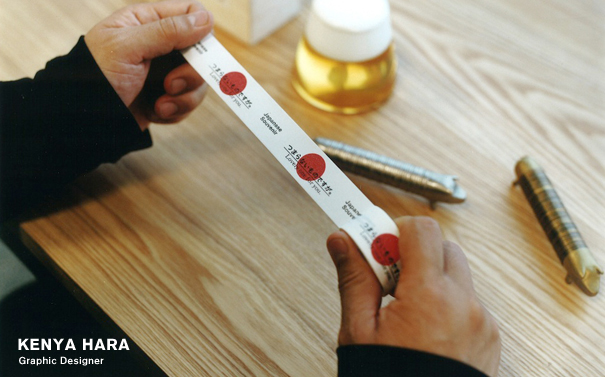
Humility to learn from the rest of the world
My favorite city is Tokyo. I'm not fond of any particular town in the city such as Roppongi or Ginza; I just like Tokyo as a whole. The Tokyo and Yokohama areas are the metropolises of the world; even now they are the world's largest city areas. The fact that so many people gather here is evidence that it is attractive. I lived in Okayama until I was 18, but I was instinctively drawn to Tokyo and came here. Not once did I think of going to Osaka or Kyoto. Even now, I have no urge to go to New York or move to Paris.
Tokyo has humility. When you go to New York, you see that people there think that New York is the center of the world. People in London think London is the center. And when you go to Milan, the people there think that Milan is the number one city in the world. But Tokyo is always studying. It always seems to be earnestly learning from the rest of the world; it tries to gather magazines from other countries, it makes efforts to invite interesting exhibitions from art museums all over the world, it has its ears pricked up attentively. Tokyo tries to make its Italian food taste better, tries to learn about making the best Chinese cuisine, and diligently studies things like Swiss watches and Chili wine. Tokyo tries to learn about all the good things in the rest of the world. I like that attitude, and I'm pleased to have a base in a city that has that kind of attitude.
Tokyo has yet to bloom
Japan has potential; I think there is plenty of power lying underneath. I'm always talking about "meticulousness, politeness, sensitiveness, and cleanliness" and these are the aspects that Tokyo Midtown and Marunouchi and Japanese cities excel in. The roads that are sloped for water drainage and the smooth continuity of the different levels between roads - all these are very well made. I don't think there is any other country that has built such a sensitive road environment. And the public toilets are clean: when I come back from abroad and use the toilets in the airport, I always think, Japan is still going strong. We should renew our recognition of the factors behind the realization of this sort of beauty.
Japan has not bloomed yet. In the Meiji Restoration, the country was exposed to the stunning Western culture, and it was thrown into chaos, and we are currently in an extremely chaotic state. Things are still murky, so it will probably take another 200 years or so for things to become calm and clear. Only about 150 years have passed since the Meiji Restoration. So it can't be helped that the cities and entertainment districts are untidy; we're right in the middle of confusion. But in the next 100 years, we might get more clarity, and then the real challenge will be to think about how we can make everything clear.
How things could grow like a majestic tree
I work with a company called Nippon Design Center and I also teach at Musashino Art University's Department of Science of Design; I also sometimes do projects such as "HOUSE VISION" and I have long been involved with companies such as MUJI and Takeo. I've also started to write a lot of books and I myself am not quite sure what I am interested in. (laughs) What has been on my mind lately is how we can make all kinds of things grow in a steady way - in the way a majestic tree grows it leaves.
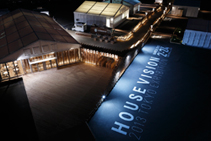
HOUSE VISION
A project based on the concept of creating new styles of city living. Comprised of manufacturers of architectural materials and housing manufacturers, architects and designers, it gives out information on living and housing in Japan. In March 2013, the "HOUSE VISION 2013 TOKYO EXHIBITION" was held in Tokyo's Odaiba.
I feel that we need to think more about connecting each part rather than just making good designs. Instead of just being curious and seeing how a thin tree will grow, we need to think about how to let the roots go deep down in the ground.
Perhaps that means not just doing things by ourselves but tossing the ball to all kinds of people. It's also about handing on the ball to the younger people or working with people with whom we had no common ground with before. I have the feeling now that the next challenge for me is to think about how to make that pass.
Editor's thoughts
The unique ideas Hara-san gave for developing a city were both eye-opening and easy to understand. The general notion still seems to be that the cities are places for work and that the areas outside the cities are where our homes should be. However, with the help of design and art, the way we live in our homes can change, and hospitals can be given a new function. Hearing Hara-san's talk, I was filled with excitement thinking about how cities might evolve in the future.(edit_rhino)




